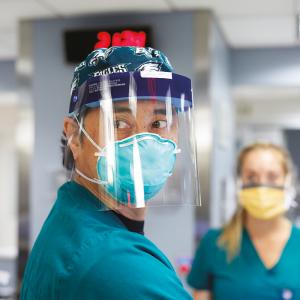To Prepare for the Uncertainties of the Pandemic, Leadership Has Devised a Multipronged Strategy to Cope with Any Scenario

Dr. Fritz François, chief medical officer and patient safety officer, has been battle-tested for leadership. Over the years, he has led a medical team on a humanitarian mission to earthquake-ravaged Haiti (his birthplace), joined colleagues as they braved 9/11 and Hurricane Sandy, and directed the response to a major fire that broke out in the Kimmel Pavilion as it was under construction.
Photo: Jonathan Kozowyk
As coronavirus disease (COVID-19) bore down on New York City in March, 2020, the number of patients presenting to NYU Langone Health’s ambulatory care sites and emergency departments with severe respiratory infections began to surge. Several days after the World Health Organization declared COVID-19 a global pandemic, Governor Andrew Cuomo made a dire prediction. “I see a wave, and the wave is going to break on the healthcare system,” he said. “And I am telling you … it is going to be a tsunami.”
One of the administrative leaders responsible for coordinating NYU Langone’s planning for and response to outbreaks was Fritz François, MD, chief medical officer and patient safety officer. As Dr. François toured the clinical units during those first days of the crisis, he sensed a surprisingly sanguine mood. “There was a lot of uncertainty, but there was a certain calm, too,” he says. “We’d been planning for many weeks, so it was simply a matter of executing our playbook. We were ready.”
Dr. François says the goal was to stay ahead of the epidemiological curve, and that it was made possible by the dedication of NYU Langone’s entire staff. “I was very confident about our execution,” he says. “There’s a spirit here that makes people rise to the challenge in unbelievable ways. Resiliency is part of our DNA. When I see such skilled, talented people perform, it’s not surprising—it’s inspiring.”
To the extent that anyone could prepare for a virus that is, as it turns out, full of surprises, NYU Langone had devised a strategic game plan, leaving as little as possible to chance. Dr. François refers to it as “The Five Ts.”
Tools
“These are the things that protect our staff,” says Dr. François, “so they’re critical.” To ensure that everyone on the front lines had the personal protective equipment (PPE) they needed, he worked closely with the Supply Chain Management team. His most urgent questions: What do we need, and how much? When, where, and how will we use these items? How long will they last, and how can we conserve and replenish them?
Teams
“Who we needed was as important as what we needed,” says Dr. François. In clinical areas such as the emergency departments (EDs), intensive care units, acute care units, and respiratory therapy units, experts collaborated to anticipate how many specialists would be required and how their care would be integrated.
Triage
Key to the workflow plan was transporting patients to an infection-controlled hospital room as soon as their initial evaluation was completed. “All the triaging steps had to be mapped out,” he says, “from the patient’s initial assessment and testing to the path from the ED to a designated bed.”
Therapies
“We had to decide which therapies we would use for acutely ill patients,” Dr. François explains. In addition to oxygen therapy and antivirals, he says, other promising treatments under investigation include convalescent plasma and monoclonal antibody therapy. “We wanted to make sure that appropriate candidates had access to these trials, so close collaboration was needed between the clinical units and the clinical trial programs.”
Throughput
“A key to our strategy,” Dr. François explains, “was to make more beds available for acutely ill patients by transferring convalescing patients to NYU Langone Orthopedic Hospital, which had beds available because it was not performing surgeries during the crisis.”

